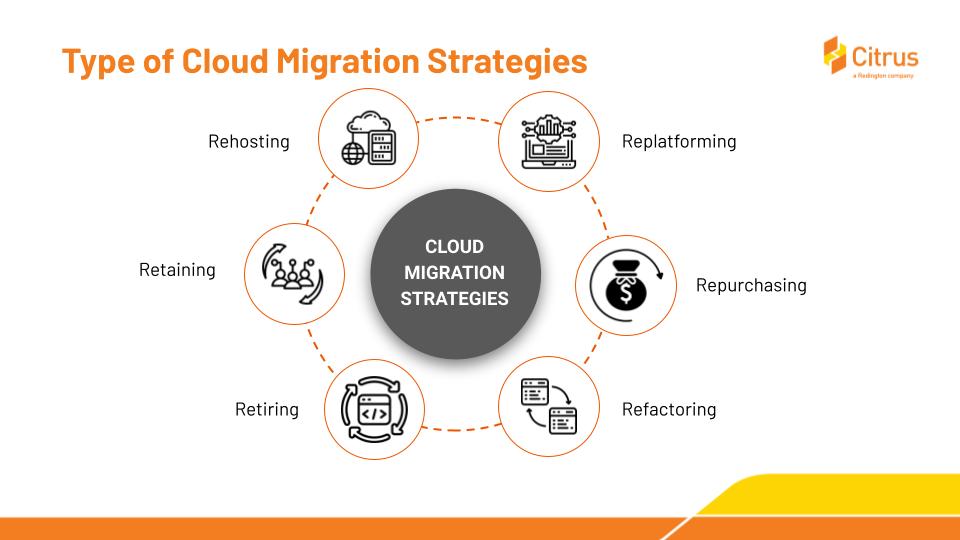
Choosing the Right Migration Strategy to Move Your Business to AWS: A Comprehensive Guide by Citrus Consulting

Identify a Migration Strategy
AWS provides a comprehensive set of migration services and tools that can assist in identifying the best migration strategy for a business. With AWS, businesses can easily migrate their infrastructure to the cloud, thus eliminating the need for on-premises hardware and software investments.
At Citrus we use the AWS Migration Hub for the seamless migration of workloads, it is a service that provides a central location to collect server and application inventory data for the assessment, planning, and tracking of migrations to AWS.
The following are the core migration strategies:
Rehosting (lift and shift): Here at Citrus, we understand that sometimes customers need to migrate to the cloud quickly and seamlessly without having to change their current architecture. That’s why we use our Rehosting strategy, which is ideal for moving applications from on-premise to AWS EC2 service with minimal disruption. However, if customers are looking to fully leverage the Cloud’s capabilities in terms of agility, scalability, and cost-effectiveness in the long run, we recommend exploring other strategies as well. So, keep reading to find out more!
Replatforming (lift, tinker, and shift): When migrating to AWS, the decision to use Replatforming depends on the current application architecture and the extent of its compatibility with the AWS environment. To determine whether Replatforming is necessary, we evaluate the workload dependencies, configurations, and performance metrics.
Firstly, we identify the components that the application relies on, including databases, middleware, and third-party tools. Next, we assess whether these components are supported by AWS or whether they need to be modified or replaced to work efficiently in the cloud. For instance, if the application uses a database system that is supported by AWS, we would suggest migrating it to Amazon RDS or Amazon Aurora.
Repurchasing (drop and shop): To decide if Repurchasing is needed when migrating to AWS, we consider the business needs and assess if the legacy applications can be replaced by a SaaS solution with similar capabilities. We evaluate the existing application’s features, functionalities, and limitations and identify commercial software products or services on AWS Marketplace that can replace it. Finally, we analyze the impact of Repurchasing on the organization, including training and adoption costs and any impact on business processes. By evaluating the existing application and available software products, we can determine if Repurchasing is the appropriate migration strategy. For example, Repurchasing can be used to migrate next-gen firewalls.
Refactoring: When migrating to AWS, refactoring an application can be a beneficial strategy if the current architecture is not well-suited for the cloud platform due to inefficiencies or limitations. We perform a thorough review of the customer’s application architecture to identify areas that can be improved for AWS. Based on the findings, we suggest changes to the architecture and code that make it more cloud-native, optimize costs, and leverage AWS services such as Lambda for running code functions, S3 for static file hosting, or DynamoDB for the NoSQL database. This may involve breaking down monolithic applications into microservices to improve scalability, flexibility, and resilience. We also offer assistance with testing and deploying refactored applications in AWS using AWS DevOps tools such as CodePipeline or CodeDeploy. To streamline the process, we utilize AWS Migration Hub Refactor Spaces, a tool that helps identify and prioritize areas for refactoring and track progress throughout the migration journey.
Retiring: When migrating to AWS, retiring an application can be a viable option if the application is no longer necessary or if the cost of maintaining it outweighs its benefits. This could be due to various reasons, such as obsolete technology or functionality, low usage or revenue, or a need for consolidation. To determine if retiring an application is the right strategy, we assess the application’s business value, technical feasibility, and impact on stakeholders. We work closely with customers to understand their business objectives and priorities and develop a plan to retire the application in a way that minimizes disruption and maximizes benefits. This could involve migrating data and functionality to other applications or services, archiving or deleting data, or decommissioning the application altogether.
Retain or Revisit: When migrating to AWS, retaining an application can be a suitable strategy if the application is still valuable and essential to the business, and the cost of maintaining it is justified rather than retiring it. This could be due to various reasons, such as compliance requirements, customer demand, or business-critical functionality. To determine if retaining an application is the right strategy, we assess the application’s business value, technical feasibility, and alignment with the customer’s strategy.
Relocate: When migrating to AWS, relocating an application can be a suitable strategy if the application is still valuable to the business but needs to be moved to a different environment or location. This could be due to various reasons, such as data center consolidation, disaster recovery, or compliance requirements. To determine if relocating an application is the right strategy, we assess the application’s business value, technical feasibility, and compatibility with AWS. We work closely with customers to understand their requirements and constraints and develop a plan to move the application to AWS with minimal disruption and downtime. One of the methods we use for application relocation is VMware Cloud (VMC) on AWS, a fully managed service that enables customers to run VMware workloads natively on AWS.
Citrus Consulting has a team of experts who can help businesses identify the best migration strategy, and guide through the entire migration process to ensure a smooth transition to the cloud.



